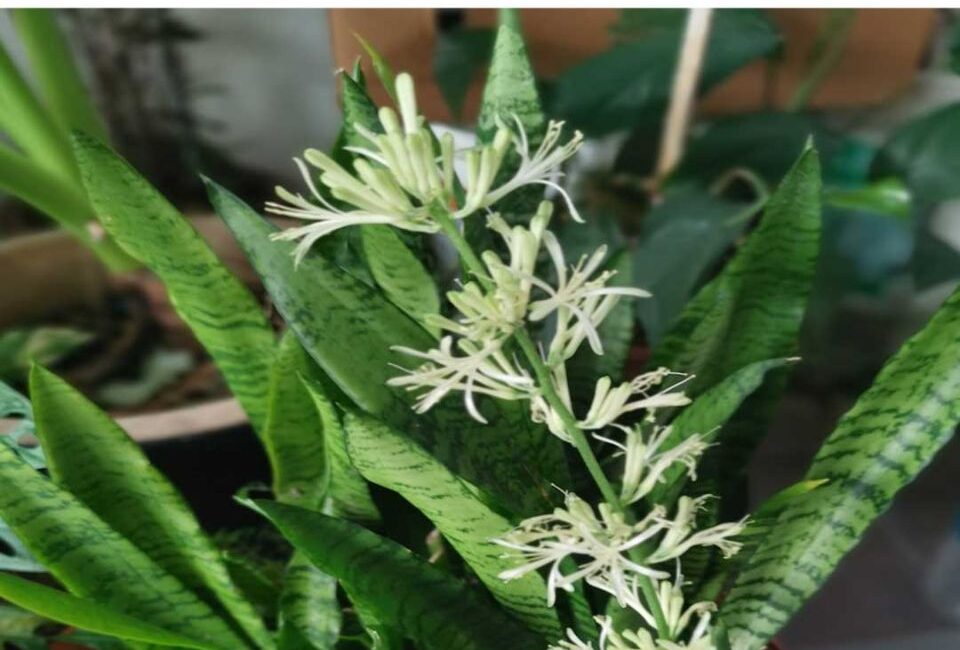Snake plants (Sansevieria trifasciata), also known as mother-in-law’s tongue, are incredibly popular houseplants. These resilient and low-maintenance plants are known for their striking upright leaves and their ability to thrive in various indoor conditions. Though commonly grown for their attractive foliage, snake plants can also bloom under the right conditions. However, many people mistakenly believe that snake plants never bloom or that they are too difficult to make bloom. In reality, getting a snake plant to flower is entirely possible with the right care and environment.
In this article, we’ll break down why most people struggle to get their snake plants to bloom, and how to correct common mistakes to ensure your snake plant produces beautiful flowers. From understanding the conditions necessary for blooming to tips on plant care and environmental adjustments, this guide will help you maximize your chances of witnessing the remarkable flowering process of your snake plant.
1. Understanding the Snake Plant’s Blooming Nature
Before we dive into the specifics of how to get your snake plant to bloom, it’s important to understand its blooming nature. While snake plants can indeed flower, they do so very rarely, especially when grown indoors. Native to West Africa, the snake plant is accustomed to subtropical climates, where the environmental conditions are very different from most indoor settings.
In their native habitat, snake plants typically bloom in the late winter to early spring months, often after the plant has gone through a period of rest. The flowers of the snake plant are small, fragrant, and usually white or pale green. The blooms appear on tall flower spikes that grow from the base of the plant. Although the flowers themselves are quite beautiful, they tend to be somewhat short-lived, and many people may never see them if the plant isn’t given the right conditions to bloom.
Understanding how blooming works in snake plants is the first step in making it happen. Snake plants need specific environmental triggers, such as the right amount of light, temperature, and care, to initiate the blooming process.
2. The Role of Light in Blooming
One of the primary reasons snake plants fail to bloom is inadequate light. Snake plants, although known for their ability to survive in low light, require some amount of bright indirect light to encourage blooming. While these plants can adapt to various lighting conditions, a lack of light will prevent them from reaching the stage where they can flower.
Snake plants are classified as low-light tolerant, but that doesn’t mean they thrive in darkness. They do best in bright, indirect light, where they can photosynthesize efficiently. In conditions where they receive too little light, the plant’s overall health can suffer, leading to slow growth, weak leaves, and a reduced chance of flowering.
For those looking to encourage their snake plant to bloom, it’s important to provide the plant with a location that gets at least a few hours of indirect sunlight each day. Placing the plant near a bright window but not in direct sunlight is ideal. If you don’t have access to natural light, a grow light can be an excellent alternative.
3. Temperature and Humidity: The Right Balance
Temperature plays a crucial role in the blooming process of snake plants. These plants are native to warmer climates, and they require a consistent temperature range to thrive. Ideally, snake plants should be kept in a room where the temperature is between 60°F and 85°F (15°C to 29°C). If the temperature is too cold, the plant may enter a dormant state, which will prevent blooming.
Humidity also plays a role in promoting flowering. Snake plants are relatively adaptable to varying humidity levels, but they do best in moderate to high humidity. Very dry air, especially in winter when indoor heating systems can reduce humidity, can stress the plant and stunt its growth.
If you want to create an ideal environment for blooming, try to maintain consistent temperatures and ensure a moderate level of humidity. If your home is particularly dry, consider using a humidifier or placing the plant on a tray with water and pebbles to increase humidity.
4. Watering: Avoid Overwatering and Underwatering
Watering is another critical factor that can influence whether or not your snake plant will bloom. Snake plants are succulents, and they are very sensitive to both overwatering and underwatering. Overwatering is one of the leading causes of root rot, which can severely damage the plant and prevent it from blooming. Conversely, underwatering can cause the plant to become stressed and deprive it of the nutrients it needs to grow and flower.
To ensure your snake plant blooms, it’s important to adopt a watering routine that suits its needs. Typically, snake plants should be watered every 2 to 3 weeks, allowing the soil to dry out completely between waterings. During the winter months, you can reduce watering even further, as the plant’s growth slows down during this time.
The key to watering your snake plant properly is to always check the soil before adding more water. If the top two inches of soil are dry, it’s time to water. Be sure to use a well-draining potting mix to avoid water retention around the roots, which can lead to rot.
5. Fertilizing: The Right Nutrition for Flowering
Fertilizing your snake plant is an important step in encouraging blooming. Snake plants don’t require a lot of fertilizer, but occasional feeding can help promote growth and flowering. Use a balanced liquid fertilizer, diluted to half strength, and apply it during the active growing season (typically spring and summer).
Avoid fertilizing during the fall and winter months when the plant is in a resting phase. Over-fertilizing can harm the plant and potentially prevent it from blooming. Stick to a light feeding schedule and focus on providing your snake plant with essential nutrients like nitrogen, phosphorus, and potassium.
If you prefer organic methods, consider using compost or a slow-release organic fertilizer. These options provide a steady supply of nutrients over time, which can help your snake plant stay healthy and more likely to bloom.
6. Potting and Repotting: Space and Soil Matter
One of the reasons snake plants fail to bloom is because they are too cramped in their pots or have poor-quality soil. Snake plants grow best when their roots have enough space to expand. If your plant is root-bound, meaning its roots have outgrown the pot, it may become stressed and stop flowering.
If you notice that your snake plant is growing slowly or has outgrown its pot, it may be time to repot it. Choose a pot that is one size larger than the current one and ensure that it has proper drainage. A well-draining potting mix, preferably one designed for succulents or cacti, will provide the right environment for healthy root growth.
While repotting, inspect the roots for any signs of rot or damage. Trim any unhealthy roots before placing the plant in its new pot. After repotting, wait for a few weeks before watering to allow the plant to adjust to its new environment.
7. Rest Periods: Allowing Your Plant to Rest
Many plants, including snake plants, go through natural growth cycles that include periods of dormancy. During these times, the plant is not actively growing or blooming. If your snake plant is not blooming, it may simply be in a resting phase. However, providing your snake plant with a period of dormancy is essential for encouraging flowering.
To give your snake plant the best chance of blooming, reduce watering and stop fertilizing during the winter months. Keep the plant in a cooler, darker location to simulate the natural resting phase. After a few months of rest, resume regular care, and you may find that your snake plant begins to bloom in the spring.
8. Patience: The Key to Blooming Success
Finally, one of the most important things to remember when trying to get your snake plant to bloom is patience. Snake plants can take several years to flower, and even under the best conditions, blooming is not guaranteed every year. However, with proper care, the chances of your snake plant flowering improve significantly.
By providing the right balance of light, temperature, humidity, water, nutrients, and rest, you can encourage your snake plant to bloom. Keep in mind that this process may take time, and the rewards are well worth the wait.
Conclusion
Snake plants are undoubtedly one of the most popular and resilient houseplants, but getting them to bloom requires a little extra effort. By avoiding common mistakes like inadequate light, improper watering, and neglecting the plant’s need for rest, you can significantly increase your chances of enjoying the beauty of their rare and fragrant flowers.
With patience, attention to detail, and the right environmental conditions, your snake plant can transform from a stunning foliage plant into a blooming beauty that will enhance your home for years to come.




